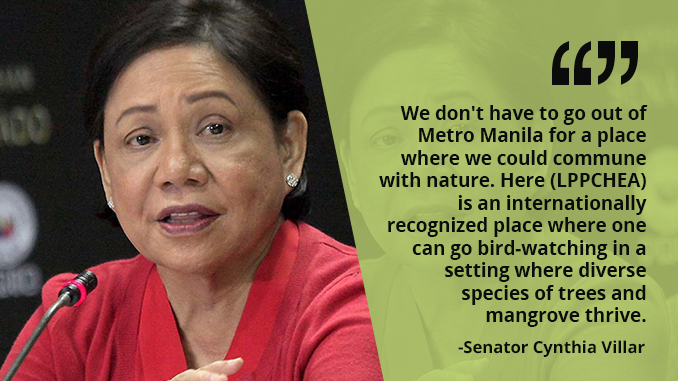Senator Cynthia Villar stressed the importance of the Las Piñas-Parañaque Critical Habitat and Eco-Tourism Area (LPPCHEA) as a bird sanctuary and mangrove site on the occasion of the 4th anniversary of the habitat’s designation as a Wetland of International Importance.
“We don’t have to go out of Metro Manila for a place where we could commune with nature. Here is an internationally-recognized place where one can go bird-watching in a setting where diverse species of trees and mangrove thrive,” Villar said.
On March 15, 2013, LPPCHEA became Site No. 2124 in the Ramsar Convention list of Wetlands of International Importance. Over 2,200 sites in the world are included in this list as a recognition of their “significant value not only for the country or the countries in which they are located, but for humanity as a whole.”
Aside from LPPCHEA, six other Ramsar sites are found in the Philippines with a total surface area of 244,017, namely: 1. the Puerto Princesa Subterranean River National Park in Palawan; 2. the Tubbataha Reefs National Marine Park in Sulu; 3. the Agusan Marsh Wildlife Sanctuary in Agusan del Sur; 4. the Naujan Lake National Park in Oriental Mindoro; 5. the Olango Island Wildlife Sanctuary in Cebu; and 6. the Negros Occidental Coastal Wetlands Conservation Area in Negros Occidental.
LPPCHEA qualified as a Ramsar site because of its compliance with Criteria numbers 2, 4, and 6 under Ramsar’s “Criteria for Identifying Wetlands of International Importance”, these are:
Criterion 2: it supports vulnerable, endangered, or critically endangered species or threatened ecological communities.
Criterion 4: It supports plant and/or animal species at a critical stage in their life cycles, or provides refuge during adverse conditions.
Criterion 6: It regularly supports one percent of the individuals in a population of one species or subspecies of waterbird.
The 175-hectare of mangrove forest and marine habitat in the cities of Las Pinas and Paranaque serves as sanctuary for 84 bird species, including migratory birds from as far as Siberia. It is the breeding site of the vulnerable Philippine Duck and supports at least 1,000 of the remaining 100,000 remaining Black-Winged Stilts in the world.
It has 36 hectares of mangrove forest, accepted as the thickest and most diverse in Manila Bay. To date, 11 species of mangroves are growing in the area.
Villar noted that the survival of this nature reserve has been threatened by reclamation projects and poor solid waste management until recently, the Department of Environment and Natural Resources (DENR) cancelled the environmental clearance certificate ECC) for reclamation projects in the area and prompted proponents to withdraw their plans.
“With these challenges out of the way, we can now proceed with the realization of our vision to develop LPPCHEA as a tourist and bird watching destination in Metro Manila,” Villar, chair of the Senate Committee on Environment and Natural Resources, said.
Villar said a memorandum of agreement was signed by DENR, the Tourism Infrastructure and Enterprise Zone Authority (TIEZA), Department of Tourism (DOT) and the Villar Social Institute for Poverty Alleviation and Governance (SIPAG) for the development of the Las Piñas-Parañaque Wetland Park at LPPCHEA just like the Hong Kong Wetland Park.
Under the agreement, DENR will allocate P10 million to build nature trails and the installation of water and electricity in the area and TIEZA will give P45 million for the construction of facilities such as the Wetland Center, birdhides, boardwalk and view towers. Villar SIPAG will donate for the construction of the visitors’ center. The Wetland Center will house a wetland museum, a training center, the office of DENR, a restaurant, and a souvenir shop.

